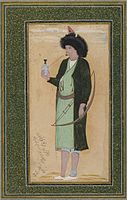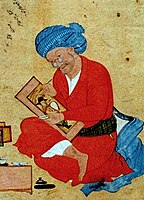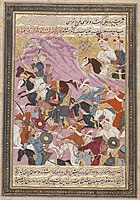Mo'en Mosavver

Mo'en Mosavver or Mu‘in Musavvir (
Muin was born in Isfahan and probably spent all of his life in this city. He enjoyed a long and successful career stretching from around 1630 to 1693.[2]
Career
He is notable as a master of illustration paintings especially figures, and compositions depicting banquet and battle scenes.[3] He specialized in illuminated manuscripts and border decorations.
He illustrated animals and landscapes and other Aqa Mirak styles with significant virtuosity. He mostly used watercolor in his painting and remained faithful to the Isfahan school and Reza Abbasi. Other prominent painters influenced him, including Behzad, Mohammadi and Sadiqi Beg. He had several prominent pupils. Some of his manuscripts are signed by them. He was contemporary and friend of famous painters including Shafi' Abbasi.[citation needed]
Gallery
-
Archer, version of this painting by Reza Abbasi
-
Portrait of Reza Abbasi, 1673
-
The battle between Shah Ismail and Shaybani Khan
-
Shah Ismail I (r. 1501-1524) watches his troops defeat the Musha'sha leader Sultan Fayyad, created c. 1688
-
Lacquer pen box, the only one known to have been painted by Muin[4]
References
- ^ Eng, Robert (2016). "Moʿin-e Moṣavver". Encyclopaedia Iranica.
- ^ "Shahnama (Book of Kings) of Firdausi - Mu'in Musavvir - 1974.290.43". The Metropolitan Museum of Art.
- ^ Massumeh, Farhad (1992). Muqarnas Volume IX: An Annual on Islamic Art and Architecture.
- ^ "Pen Box". Khalili Collections. Retrieved 2021-04-12.
- ^ "Youth in European Dress and Young Woman with Indian Headdress, from a Shahnamah". Khalili Collections. Retrieved 2021-08-11.








![Lacquer pen box, the only one known to have been painted by Muin[4]](http://upload.wikimedia.org/wikipedia/commons/thumb/2/2c/Khalili_Collection_Islamic_Art_laq-0001-top-side.jpg/200px-Khalili_Collection_Islamic_Art_laq-0001-top-side.jpg)
![Woman with Indian headdress, from an exemplar of the Shahnameh, 1648[5]](http://upload.wikimedia.org/wikipedia/commons/thumb/5/53/Khalili_Collection_Islamic_Art_mss_1000.2a.jpg/120px-Khalili_Collection_Islamic_Art_mss_1000.2a.jpg)